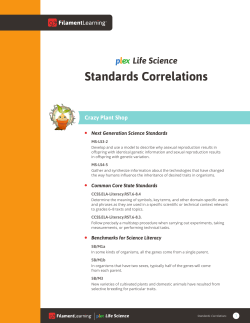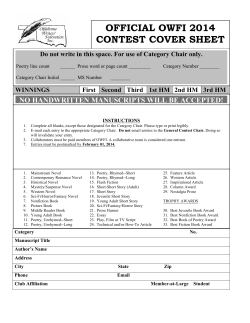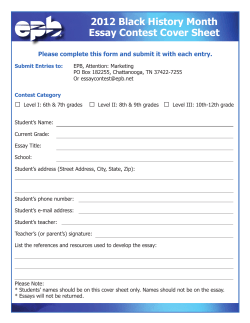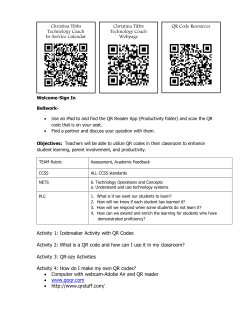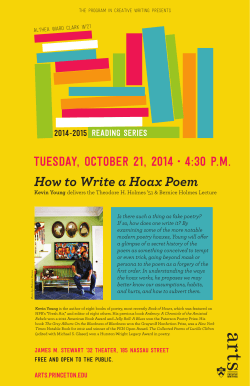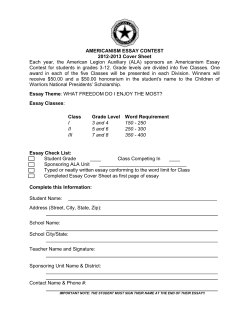
PARENTS AS PARTNERS: Reading, Writing, & Technology in the Classroom and at Home
PARENTS AS PARTNERS: Reading, Writing, & Technology in the Classroom and at Home Marites Manikad (Gr. 3) | Susan Brody (Gr. 4) Michael Mack & Tim Beaumont (Gr. 5) WELCOME! ● Introductions & Parent Survey ● 3 Guiding Questions: ○ How does curricular alignment with Common Core develop students as readers and writers? ○ How does technology support students’ success? ○ How can you support students’ academic progress? OUR #1 PRIORITY “Literacy is the spine that holds everything together and ties content together in every subject.” Mike Schmoker COMMON CORE OVERVIEW Vision: literate students who are prepared for success in the 21st century Mission: develop skills that are essential for college, career, and life: > Critical-thinking skills > Cogent reasoning > Close & attentive reading > Evidence collection skills http://www.corestandards.org/ELA-Literacy/ COMMON CORE SHIFTS 1. Building knowledge through content-rich nonfiction 2. Reading, writing, and speaking grounded in evidence from text, both literary and informational 3. Regular practice with complex text and its academic language Source: achievethecore.org COMMON CORE: IMPACT ● ● ● ● K-12 Application Vertical Integration Rationalization Delivery via Units of Study ● Change in Emphasis 3rd GRADE: Reading Units: ● ● ● ● ● Launch Nonfiction Realistic Fiction Close Reading Character Study Through Series Books ● Myths ● Author Study: Roald Dahl CCSS.ELA-LITERACY.RL.3.1 Ask and answer questions to demonstrate understanding of a text, referring explicitly to the text as the basis for the answers. CCSS.ELA-LITERACY.RL.3.2 Recount stories, including fables, folktales, and myths from diverse cultures; determine the central message, lesson, or moral and explain how it is conveyed through key details in the text. 3rd GRADE: Writing Units: ● Personal Narratives ● Feature Article/Informational ● Expository/Opinion ● Multi Genre Writing ● Realistic Fiction ● Myth ● Biography CCSS.ELA-LITERACY.W.3.1.A Introduce the topic or text they are writing about, state an opinion, and create an organizational structure that lists reasons. CCSS.ELA-LITERACY.W.3.3.A Establish a situation and introduce a narrator and/or characters; organize an event sequence that unfolds naturally. 4th GRADE: Reading Units: ● Understanding Characters ● Navigating Complex Texts: Focus on Historical Fiction (with Book Clubs) ● Nonfiction Articles & Narrative Nonfiction ● Poetry ● Author Study: Patricia MacLachlan 4th GRADE: Writing Units: ● ● ● ● ● ● Personal Narrative Persuasive Essay Literary Essay Nonfiction Articles Poetry Biography 5th GRADE: Reading Units: ● Fiction ● Nonfiction ● Close Reading ● Poetry ● Author Study Sample Skills: ● Understand Vocab. ● Extract Details ● Develop Gist & Theme ● Synthesize Character ● Analyze Structure ● Evaluate Media ● Compare & Contrast 5th GRADE: Writing Units: ● ● ● ● ● ● Narratives Informational Literary Essay Research Essay Poetry Op-Ed Sample Skills: ● Understand Structure ● Develop a Thesis ● Deploy Evidence ● Elaborate ● Use Transitions ● Vocabulary TECH. INTEGRATION (1) ● newsela.com ○ ○ ○ ○ CCSS-aligned Leveled articles High interest Instant feedback ○ Focus on analysis & evaluation TECH. INTEGRATION (2) ● Google Drive and Classroom ○ CCCS & PARCC ○ Docs ■ Conferences ■ Comments & Suggestions ○ Slides ■ Create slideshow presentations ■ Student collaboration TECH. INTEGRATION (3) ● Edmodo ○ ○ ○ ○ Preparation for Middle School Monitored student interaction Instant feedback on assessments Cross classroom/school interaction PARENT PARTNERSHIP ● Read ○ With your children; to your children; let them see YOU reading ● Write ○ With your children; to your children; let them see YOU writing ● Require evidence for all opinions! RESOURCES ● Common Core State Standards: http://www. corestandards.org ● Parent Road Map: Council of the Great City Schools, http://www.cgcs.org ● Achieve the Core: http://achievethecore.org/ ● newsela: http://newsela.com/ QUESTIONS?
© Copyright 2025





